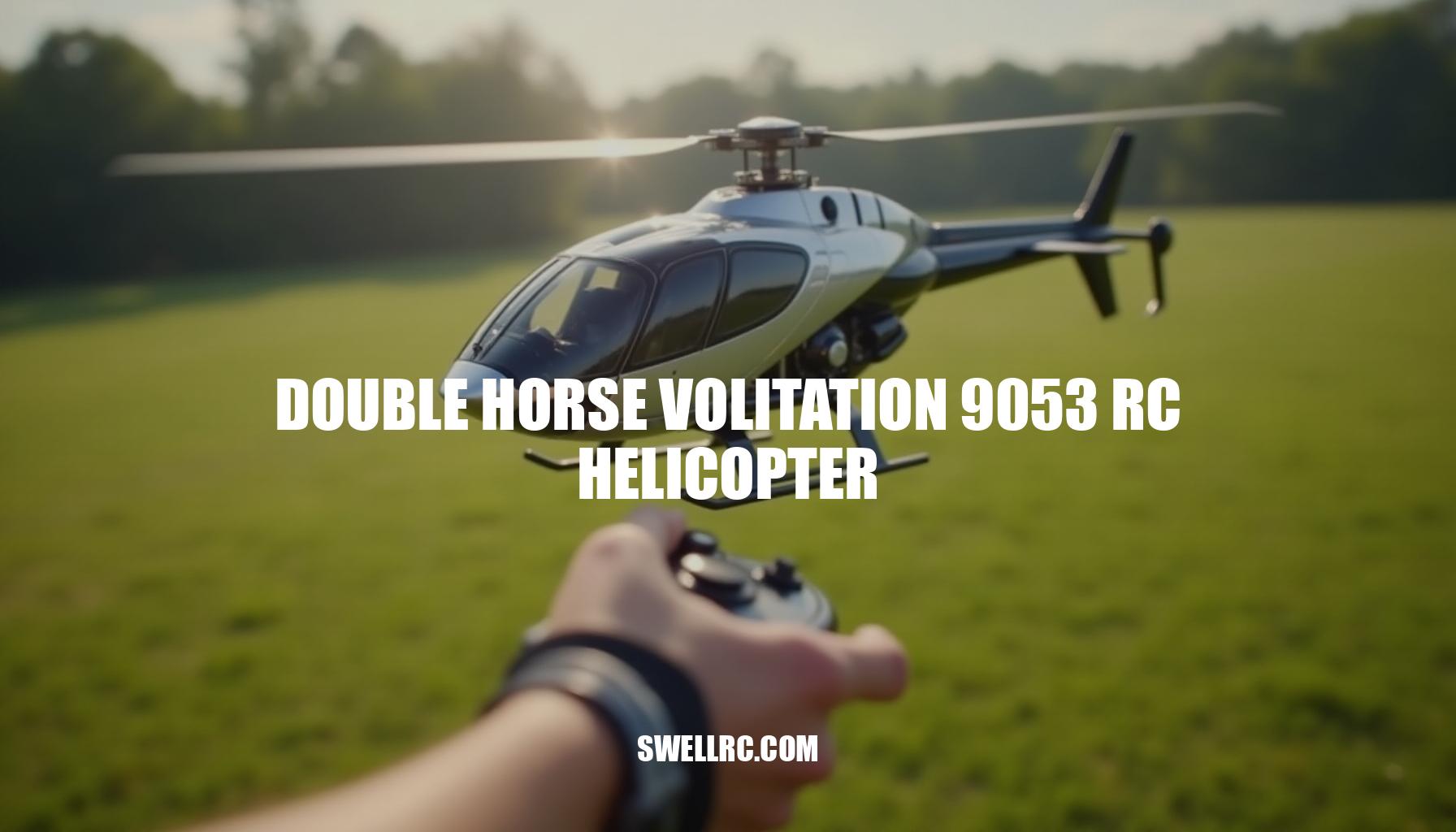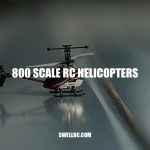Double Horse Volitation 9053 RC Helicopter Review and Guide
The first time I spooled up the Double Horse Volitation 9053 RC Helicopter, I felt that old-school RC magic—big rotors, steady hover, and a surprisingly gentle learning curve that begged me to keep flying until I figured out what made this model tick. The 9053 sits firmly in the beginner RC helicopter category, perfect for those stepping into the world of RC aviation. As a classic coaxial helicopter featuring a 3.5 channel heli configuration, it offers stable response and intuitive controls, making it ideal as a large outdoor RC chopper designed for relaxed cruising rather than aggressive aerobatics.
This helicopter’s size-driven presence and forgiving handling make it beloved by many RC aviation hobbyists, especially those seeking a stable hover experience to build confidence. In this detailed RC aviation hobbyist review, I’ll break down the Double Horse Volitation 9053’s design and build quality, share real-world flight performance impressions, outline key technical specs, discuss control feel, offer essential maintenance tips, and explore some smart alternatives. Whether you’re a novice pilot or an enthusiast looking for a reliable, easy-to-fly model, this guide will provide hands-on insights you can trust.
The Design Story: Build, Looks, and Engineering Precision
Up close, the 9053 is a big coaxial airframe showcasing excellent build quality with its robust metal frame and durable ABS canopy. Its classic flybar stabilizer sits gracefully over stacked main rotors, contributing to a dependable coaxial rotor system that ensures rock-solid hover stability—ideal for beginners. The tail-mounted pusher motor efficiently manages forward pitch, balancing control and ease of flight.
| Feature | Specification | Benefits |
|---|---|---|
| Build Quality | Metal Alloy Frame + ABS Canopy | Enhances durability and impact resistance during beginner flights |
| Rotor Structure | Coaxial Rotors with Flybar | Provides stable hover and easy control for new pilots |
| Dimensions | Length: 700–780 mm; Rotor Diameter: 500–540 mm | Offers substantial size for presence without sacrificing manageability |
| Weight | 700–950 g (varies by battery and batch) | Heavy enough to avoid twitchiness yet light enough for easy handling |
| Landing Gear | Flexible Landing Skids | Helps absorb shocks during beginner landings, reducing damage |
When compared to the Double Horse 9101, the 9053’s coaxial rotor system paired with its flybar offers significantly more stability, although it sacrifices some of the sporty responsiveness found in the 9101. Against the scale micro-class Yuxiang F09 Black Hawk, the 9053 prioritizes size and solid build quality over intricate scale detailing, a trade-off that enhances overall durability and makes it a perfect choice for new pilots focusing on learning flight basics rather than scale accuracy.
Overall, the 9053’s combination of a metal-alloy metal frame, stable coaxial rotor design with a classic flybar, and robust ABS canopy delivers a reassuringly weighty but manageable helicopter that stands out in its class for beginners needing reliability and ease of control.
Power and Flight Performance: Tested in Real Air
Setting up the 9053 is straightforward: charge the 7.4 V pack, power the transmitter, bind, and gently ease into throttle. The flight performance on first lift-off is impressive—the 9053 climbs smoothly with minimal yaw drift and maintains a calm hover, showcasing the stability that its coaxial layout promises. Directional inputs are gentle; although you won’t carve tight figure-eights like with a collective-pitch machine, the predictability makes it an excellent choice for novice to intermediate pilots.
When it comes to outdoor handling, the 9053 excels in light winds but starts to feel nudged around when the breeze exceeds 6–8 mph, highlighting its wind handling limitations. Expect around 8–10 minutes of flight on a healthy 9053 battery life, with 2–3 hours required to recharge depending on your charger. The typical control range falls between 30–50 meters on 2.4 GHz variants, which is adequate for casual flying sessions.
For comparison, models like the Hero RC H911 and Esky 150 V3 offer snappier handling and increased agility; however, neither matches the large-heli float and stability that the 9053 delivers, making it a standout in its category.
Below is a summary of the key pros and cons based on multiple battery cycles:
- Pros: Predictable and stable flight performance, excellent hover capabilities, smooth climb with minimal drift, suitable for beginners, sizable flight times, decent control range.
- Cons: Limited agility compared to Hero RC H911 and Esky 150 V3, susceptible to wind gusts over 6–8 mph, relatively long battery recharge time.
Technical Specs & Innovations That Matter
Understanding the Double Horse 9053 specs is key to appreciating why this model offers a stable and accessible flying experience. Featuring coaxial main rotors complemented by a flybar, it effectively puts stability on autopilot. This setup, combined with dual brushed motors, emphasizes simplicity and low maintenance rather than maximizing raw power.
The inclusion of a 2S Li-ion battery (7.4 V) carefully balances the helicopter’s weight and overall flight time, while a 3.5-channel radio system grants control over throttle, yaw, and forward/back pitch, enhanced further by built-in gyro stabilization.
Below is a table outlining the key technical specifications for quick reference. Keep in mind that specs may vary slightly across different production runs, so these figures serve as typical examples rather than absolute values.
| Specification | Details |
|---|---|
| Rotor Diameter | Approx. 17 cm (coaxial rotors) |
| Motors | Dual brushed motors for durability and low maintenance |
| Battery | 2S (7.4 V) Li-ion battery balancing weight and flight time |
| Control Channels | 3.5-channel radio with throttle, yaw, forward/back pitch |
| Stabilization | Gyro stabilization with flybar for enhanced stability |
For enthusiasts seeking greater agility and advanced flight capabilities, modern collective-pitch helicopters like the WLToys V950 or the XK K110S offer impressive performance enhancements. However, these models require significantly better piloting skills compared to the straightforward and stable design of the Double Horse 9053.
Learning to Fly: Handling and Control Experience
The transmitter feel of the Double Horse 9053 is basic but intuitive, designed to help beginners get comfortable with remote control helicopter basics quickly. The left stick controls throttle and yaw, while the right stick manages forward and backward movement with some lateral correction via yaw. Adjusting trims is essential; the trim tabs help tame minor drift, making it easier for new pilots to maintain steady flight.
The onboard gyro performance is impressive for a model of this class, keeping the nose composed during hover and allowing pilots to focus more on mastering flight control rather than constant correction. For those learning how to fly Double Horse 9053, these features are especially helpful on day one.
Here are some beginner RC tips to keep in mind:
- Start practicing tail-in hovers first, which make directional control more intuitive.
- Use a flat, open field with ample space to safely explore the control range without risking damage.
- Treat the throttle like a dimmer switch: make small inputs, wait for the helicopter’s response, then adjust again.
- Avoid rapid stick movements; the Double Horse 9053 responds best to smooth, deliberate inputs.
- Keep the helicopter close while learning to better judge momentum, as larger coaxials tend to have a bit of float on approach.
If you’re unfamiliar with radio systems and channel modes, this guide to helicopter transmitters provides an excellent primer and will enhance your understanding of RC controls significantly.
Maintenance, Repairs, and Real-World Longevity
Ownership of an RC helicopter like the 9053 is straightforward if you keep up with basic maintenance. Over time, expect to perform replacement parts tasks such as changing main blades, flybar links, landing skids, and batteries. Fortunately, these components are inexpensive and easy to swap.
To ensure long-term durability, keep shafts clean, regularly check gear mesh, and allow the motors to cool between battery packs.
For valuable RC helicopter resources including parts sources and community knowledge, start with websites like SwellRC’s RC helicopter websites. In terms of resilience, the 9053 model shrugs off light tip-overs well; however, hard nose-ins may crack the canopy or bend the flybar.
| Model Comparison | Durability & Repair | Maintenance Focus |
|---|---|---|
| 9053 RC Helicopter | Simple to keep airworthy, inexpensive repairs | Blades, flybar, batteries, gear mesh |
| Boeing CH-47 Chinook RC Helicopter | Larger scale, more complex maintenance | Detailed mechanical upkeep |
| Eachine E200 RC Helicopter (Flybarless) | More precise in wind, but higher repair costs | Advanced electronics, precise tuning |
When it comes to storage advice, always store batteries at their recommended storage voltage, avoid excessive heat, and inspect all screws on a weekly basis to prevent loose components. After several months of use, the main wear items typically include the blades and potentially a tired 2S battery pack — both are easy and affordable to fix.
- Maintain clean shafts and proper gear mesh.
- Allow motors to cool between battery packs.
- Regularly inspect screws and landing gear for damage.
- Replace worn blades and batteries promptly.
- Consult trusted RC helicopter websites for repair tips and parts.
Alternatives and Upgrades Worth Exploring
If you love the Double Horse 9053‘s stability but want to explore the best alternatives to Double Horse 9053, here are some solid upgrade paths that cater to different flying styles and preferences. The Double Horse 9101 maintains the brand’s approachable vibe but offers a fresh layout, ideal for pilots seeking a slightly different experience. For those curious about collective pitch vs coaxial dynamics, the Esky 150 V3 provides a more agile feel within a smaller footprint, perfect for improving flight skills.
The XK K110S stands out as a wildly capable collective-pitch trainer that grows with your ability, bridging the gap between beginner and advanced. If you’re looking for outdoor performance, the WLToys V950 carries bigger collective pitch (CP) energy, commanding more power and precision.
On the scale side, the Yuxiang F09 Black Hawk is perfect for pilots prioritizing looks-first flying, combining aesthetics with control. The modern Eachine E200 brings flybarless manners for a smooth, contemporary piloting experience. For a compact and budget-friendly option, the Hero RC H911 offers nimbleness without breaking the bank.
Below is an RC helicopter comparison table that summarizes key features like price comparison, flight time, and skill level suitability, helping you match the best heli to your goals.
| Model | Type | Price Range | Flight Time | Skill Level |
|---|---|---|---|---|
| Double Horse 9101 | Coaxial | $40–$60 | 8–10 mins | Beginner |
| Esky 150 V3 | Coaxial | $70–$90 | 10–12 mins | Low Intermediate |
| XK K110S | Collective Pitch | $120–$150 | 6–8 mins | Intermediate to Advanced |
| WLToys V950 | Collective Pitch | $100–$130 | 7–9 mins | Intermediate |
| Yuxiang F09 Black Hawk | Coaxial Scale | $60–$80 | 8–9 mins | Beginner to Intermediate |
| Eachine E200 | Flybarless Collective Pitch | $130–$160 | 7–9 mins | Intermediate |
| Hero RC H911 | Coaxial | $30–$45 | 6–7 mins | Beginner |
Final Thoughts: Why the 9053 Still Deserves Attention
In this Double Horse 9053 review, what surprised me most was how relevant this model still feels for stress-free flying days. It’s not designed as a stunt machine, yet every gentle circuit reminded me why I fell in love with RC aviation—offering predictable lift, smooth hovers, and a big-heli presence without big-heli intimidation.
Who it’s for:
- Beginner RC helicopter pilots seeking stability over complexity
- Casual park flyers who appreciate simplicity and size
- Nostalgic RC enthusiasts valuing floaty, calm sorties rather than acrobatic maneuvers
Strengths and Weaknesses (Stability vs Agility):
| Strengths | Weaknesses |
|---|---|
| Excellent stability and forgiving flight characteristics | Lower wind resistance making it less suitable in windy conditions |
| Generous size that aids in visibility and control | Limited agility, not intended for advanced acro flying |
| Simple design perfect for newcomers | Performance ceiling may leave more advanced pilots wanting more |
Buying advice: If you are a beginner or someone returning to RC helicopters looking for a reliable, easy-to-fly model, the Double Horse 9053 is an excellent choice. For flyers who eventually crave more performance and nimbleness, exploring more advanced alternatives discussed in related guides will offer clear next steps.
Final verdict: The Double Horse Volitation 9053 remains a welcoming gateway to the hobby, combining stability, size, and simplicity in a package that encourages calm, enjoyable flying. For those prioritizing a stress-free and predictably smooth experience, this model is definitely worth celebrating.
Frequently Asked Questions
- Is the Double Horse Volitation 9053 suitable for beginners?
Yes. Its coaxial, 3.5‑channel setup and flybar stabilization make hovering and gentle circuits easy. It’s ideal for first flights outdoors in calm conditions. - How long can the 9053 RC helicopter fly on a full charge?
Typically 8–10 minutes on a healthy 2S (7.4 V) pack, assuming calm weather and conservative flying. Charging with stock chargers usually takes 2–3 hours. - What’s the difference between the Double Horse 9053 and 9101?
The 9053 is a large coaxial heli prioritizing stability and smooth hover. The 9101 leans smaller and sportier. The 9053 feels calmer; the 9101 feels more responsive but less floaty. - Why does my Double Horse 9053 drift to one side?
Minor drift is common and usually resolved with trim adjustments, checking for bent flybar links or uneven blade wear, and ensuring the battery is centered and fully charged. - Can the Double Horse 9053 handle outdoor wind?
Light breeze only. It’s happiest under ~6–8 mph. Coaxials excel at stability but have limited forward authority in stronger winds. - Where can I find replacement parts for the 9053 helicopter?
Check major RC retailers and community hubs; blades, skids, flybars, and batteries are common. Guides and sources are listed on reputable RC helicopter websites. - Are there better alternatives to the Double Horse Volitation 9053 today?
If you want more agility or wind performance, consider flybarless or collective-pitch options like the XK K110S or WLToys V950. For simple, calm flying, the 9053 still delivers great value.



